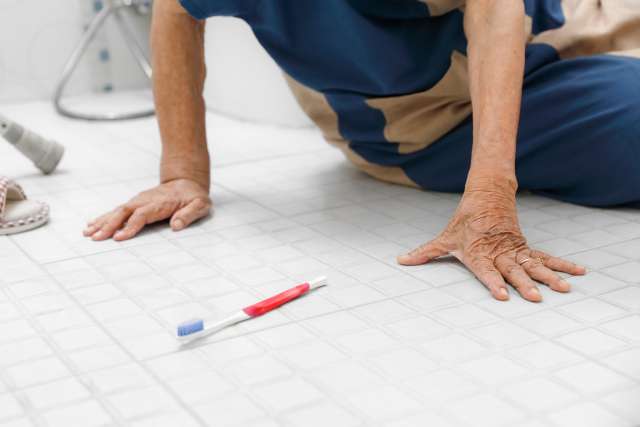UCLA Health geriatric specialists have zeroed in on factors that contribute to older adults falling and a personalized approach to better prevent those falls.
After a 2020 study found that a broad attempt to implement fall prevention strategies across multiple health systems had modest effect on lowering the number of falls among adults 70 and older, UCLA Health’s David Reuben, MD, and David Ganz, MD, PhD, have turned their attention to finding a more effective strategy. Simply put, it’s “when there’s an individual provider who’s trained appropriately working with a motivated patient,” said Dr. Ganz, a geriatrician and professor-in-residence at the David Geffen School of Medicine at UCLA.
Falls are the leading cause of injury-related death among adults 65 and older, according to statistics from the Centers for Disease Control and Prevention, and these deaths are on the rise. Factors that play a part in preventing falls include exercise, regular vision checks, examination of footwear, and cognitive assessments, among others — and a health care provider may be the best person to address these issues directly with patients, Dr. Ganz said.
The study conducted five years ago by Dr. Ganz and Dr. Reuben, also a professor of medicine at UCLA Health, implemented an approach to fall prevention at the broader health care system level. The study, Strategies to Reduce Injuries and Develop Confidence in Elders, or STRIDE, enrolled 5,451 people who were 70 and older and were at risk of fall injuries. The results were published in the New England Journal of Medicine.
Why are fall-related deaths on the rise?
The increase in deaths from fall-related injuries may partly be due to the fact that older people are living longer than they would have in the past, especially among the 85-and-older age up, Dr. Ganz noted.
“The population is aging. People are living into older ages than they've ever lived before, so one possibility is that an injury that might be non-fatal in a younger person could be fatal in an older person — somebody in their 90s, for example,” he said.

Older adults are also prescribed a lot of medications, and some side effects can cause unsteadiness. For men, a class of medications for the prostate can potentially cause dizziness. And some over-the-counter medicines can cause drowsiness which could lead to a fall, said Dr. Ganz.
“Blood thinners can help prevent stroke and prevent blood clots in your legs or in your lungs, but they also increase the risk of bleeding,” he said. “So, if you fall and you hit your head, you could have a bleed in your head. Balancing those risks is hard.”
Furthermore, medications affect people differently as they age. “A person could be on a medicine that's perfectly appropriate for them as a younger person, but as they age, the ability of their body to manage that medicine can change,” says Dr. Ganz. “So what would've been safe in a younger person can become unsafe as the person ages.”
Importance of physician assessment
The answer is not for older people to stop taking medications, but for their doctors to review those medications regularly and assess the risks versus benefits of each, says Dr. Ganz.
A health care provider can offer individualized suggestions based on the unique challenges each of their patients is facing as they get older.
“We know that the risk of falling goes up at age 65 and up,” said Dr. Ganz. “It continues to rise in the older adult population. (With the broad approach to fall prevention) it was challenging to ensure that everyone got the help that they needed.”
In addition to fall prevention measures such as a medication review, removing tripping hazards from the home, and installing grab bars in key spots such as the shower, another critical part is starting an exercise routine that increases balance, said Dr. Ganz. He and Dr. Reuben emphasized this in an opinion piece published in JAMA in 2024.
Functional exercises focused on balance and the movements older adults perform in their everyday activities seemed better at preventing falls than just walking for exercise or doing resistance training by itself, they said.
“For the average person age 65 and older, it needs to be exercise that challenges your balance,” said Dr. Ganz. “For example, tai chi is certainly one way and there's evidence for that being effective. And strength and resistance training are often part of exercise for fall prevention, too. But a big piece is the balance training,” he said.
“You can start out by holding on to something stable, like the edge of a kitchen counter, and just stand on one leg for 10 seconds and see how you do, then switch to the other leg.”
Another exercise Dr. Ganz recommends is chair-stands. “You sit in a chair and then just stand up using your legs and not your hands to push yourself up. This helps with lower extremity strength.”
Anyone can start these simple exercises at any time to improve their balance and strength, but it’s best to consult a health care provider for guidance.
“Even people who are less physically active and not getting out of the house as much can still do exercises based on their level of ability and derive some benefit from it,” said Dr. Ganz.
As the population continues to age, these steps to preventing falls will become increasingly important for older adults and their doctors to evaluate and implement.




